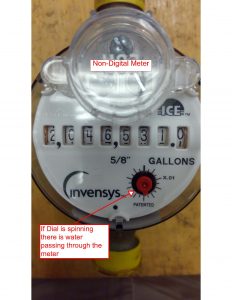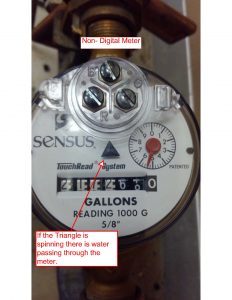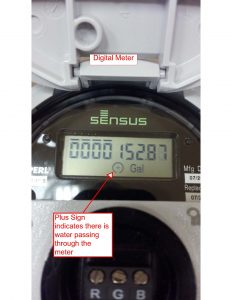Leak Detection
The quickest and easiest way for you to check for a suspected water leak in your home is to locate your water meter. Your meter is generally located in the basement or utility room near the hot water heater or under the sink in your kitchen. The Company is currently using 2 different types of meters for measuring water consumption – digital and non-digital. Follow these steps to check for leaks in your home.
1. Make sure no water is running anywhere in the house. On the non-digital meter, watch to see if the black triangle or small red dial is moving. If there is movement, this indicates that water is passing through the meter and you may have a leak. Similarly, on the digital meter, a plus sign will be visible on the screen if water is passing through the meter, which may indicate a leak.
2. The next thing you can do is to write down the read off your meter and then do not use water for a few hours (either when you go out in the morning, or overnight). When you return, read the meter again and see if the numbers have gone up.
3. The third thing you can try if you suspect you have a toilet leak is to place a few drops of food coloring or dark colored juice in the back tank of the toilet. Do not flush the toilet and wait a half hour or more. If the color seeps into the bowl, you have a leak in that toilet.
If you find a leak, call a plumber immediately to have it repaired. Even a small leak can add thousands of gallons to your water bill and become very costly. Remember, you are always responsible for water that passes through the meter, even if it is the result of a leak. The Company does not reimburse customers for faulty plumbing. If you contact our office after normal business hours and request a service technician come out to your property, there is a $100 after hours fee that will be charged to your account. Click below for photos of the various meters currently installed in our system.
For more helpful information, please visit the US Environmental Protection Agency’s website at https://www.epa.gov/watersense
SERVICE LINE LEAK
If you suspect that your water service line is leaking, please call our office to set an appointment to have a technician investigate. The technician will shut the water off at the curb stop and leave it off for several hours to determine if the water stops flowing. Plumbers, contractors and/or homeowners are not permitted to operate the Water Company’s curb stop. An appointment must be made with the company to have the water turned off. During normal business hours, there is no charge to turn the water off for a leak investigation. After normal business hours, there is a $100 fee to turn the water off. The same applies for turning the water on.
Please note, the water company is responsible for the curb stop itself, which is the shut off out at the street, as well as the water meter, which can be located either inside the home or outside in a meter pit. The customer is responsible for the service line from the curb stop to the home as well as all water lines inside the home and back out to any outdoor water fixtures, like a sprinkler system or fountain.
Our technicians are not licensed plumbers and will not be able to detect exactly where the leak in a service line is located. The customer is responsible for resolving all water line issues that occur on their private property. The final decision as to how the customer’s service line is repaired is between the customer and their licensed plumber or contractor.
Leaks on the customer’s service line that are not repaired in a timely manner will be turned off due to a willful waste of water and will not be turned back on until the repair has been made.



